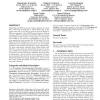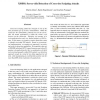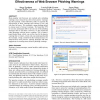96 search results - page 5 / 20 » Protecting browser state from web privacy attacks |
CCS
2008
ACM
13 years 9 months ago
2008
ACM
Single-Sign-On (SSO) protocols enable companies to establish a federated environment in which clients sign in the system once and yet are able to access to services offered by dif...
ACSAC
2008
IEEE
14 years 2 months ago
2008
IEEE
Cross-site Scripting (XSS) has emerged to one of the most prevalent type of security vulnerabilities. While the reason for the vulnerability primarily lies on the serverside, the ...
CCS
2007
ACM
14 years 2 months ago
2007
ACM
We propose BeamAuth, a two-factor web authentication technique where the second factor is a specially crafted bookmark. BeamAuth presents two interesting features: (1) only server...
CHI
2008
ACM
14 years 8 months ago
2008
ACM
Many popular web browsers now include active phishing warnings since research has shown that passive warnings are often ignored. In this laboratory study we examine the effectiven...
CCS
2009
ACM
14 years 2 months ago
2009
ACM
We study the security of embedded web servers used in consumer electronic devices, such as security cameras and photo frames, and for IT infrastructure, such as wireless access po...



